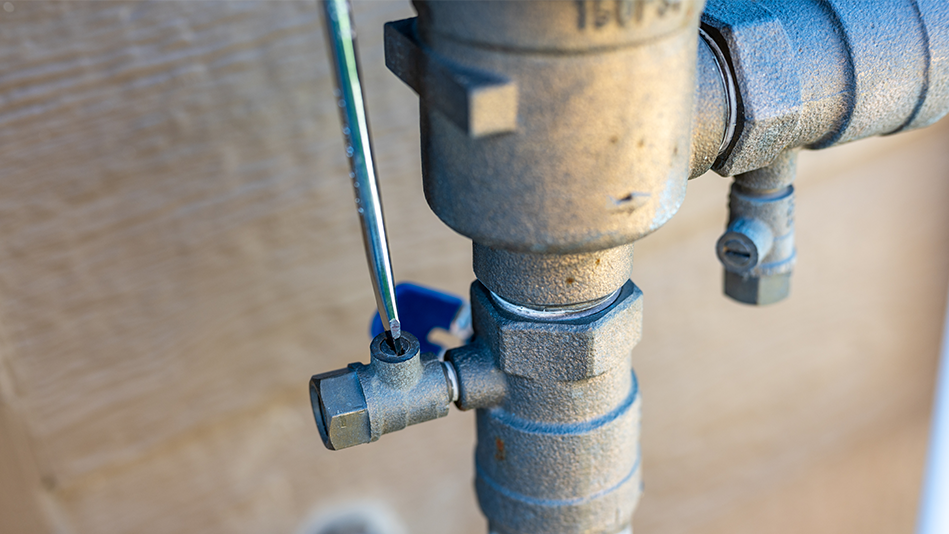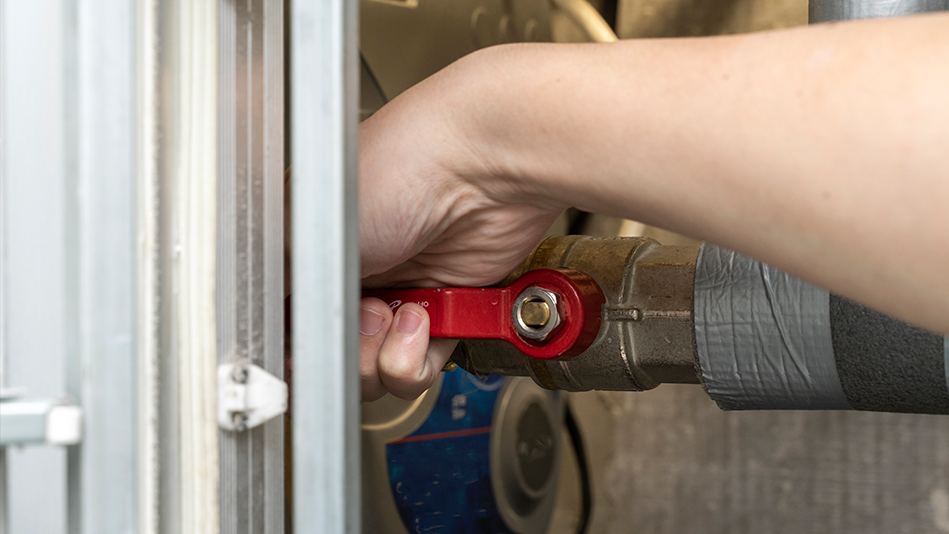Spring has sprung, and it’s time to de-winterize those lawn sprinklers. But don’t jump right to turning on the water! Take these important steps to prevent damage and ensure your sprinkler system starts up smoothly.
Operating your sprinkler valves
PRO TIP: You’ll be opening and closing some valves, so here’s how to tell which position they’re in.
- Valves are open when the handles are parallel (pointing the same direction) with the pipe.
- Valves are closed when the handles are perpendicular (pointing crossways) with the pipe.
- The same applies to test cock (TC) valve screws (which can be turned using a flathead screwdriver): A parallel line means it’s open, a perpendicular line means it’s closed.

- In all cases, turn valves counter-clockwise (or lefty-loosey) to open; turn clockwise (righty-tighty) to close. In most cases, a one-quarter turn is all you need to fully open or close a valve.
Recharging your sprinkler system
Back when you winterized your sprinkler system, you should have removed all of the water to prevent freezing damage. Now you’ll need to recharge the system with water in a series of steps.
Outside at the backflow preventer

- Locate the backflow preventer outside and give it a quick inspection for any cracks, broken seals, or leaks.
- Ensure the drain plug is tight.
- Close the backflow preventer valve handles. There should be two (2): One between the water source from the house and the backflow preventer, and another between the backflow preventer and the zone valves.
- Use a flathead screwdriver to close the test cock valve(s) by turning the screw(s) clockwise until the lines are perpendicular to the test cocks themselves. Now you can head to the basement.
In the basement
- Locate the water source for your sprinkler system in the basement, then close the drain (on the pipe) that you opened last winter. (Leaving this open can cause flooding when you turn on the water!)
- IMPORTANT: DO NOT turn any water valves all the way open at once, which can create a water hammer that competes with the air in the pipes and can cause expensive damages. This is unsafe for anyone still up in the yard as well, as the force of the water can cause sprinkler heads and other parts of your system to go flying.
- Slowly turn the water valve counter-clockwise until you hear water flowing. Once the sound of water flow stops, slowly turn the water valve the rest of the way open, making sure you hear no water moving through it. Your pipes are now charged to the backflow preventer.
Back outside at the backflow preventer
Just a few last steps to get your lawn sprinkler system going!
- Slowly start opening the first handle valve (closest to the water source) and you should hear it start to gurgle and fill the backflow preventer. Some water may squirt out near the top, but only for a moment before the seal completes. Then you can slowly open the first valve handle the rest of the way. It is fully open when it is parallel to the pipe.
- Now that the backflow preventer is fully charged, it is time to open the valve that goes to the rest of your lawn sprinkler system. Once again, you will open this slowly, just until you can hear water start coming through. Leave it only partially open until you hear the flow of water stop, and then slowly open it the rest of the way. Listen for any water sounds, and if there’s nothing, your pipes are now charged through the zone valves.
- Go to your zone valves and open each zone for a minute or two to bleed any remaining trapped air out of the system.
Doing a final inspection
Now you can walk through each zone to check for uneven or mis-directed sprays (sprinkler head issues) or low-pressure sprays (leak issues)—these lawn sprinkler maintenance tips can get you started. Have a great spring!
Visit us on Facebook, LinkedIn, Twitter or Instagram to tell us your thoughts!
